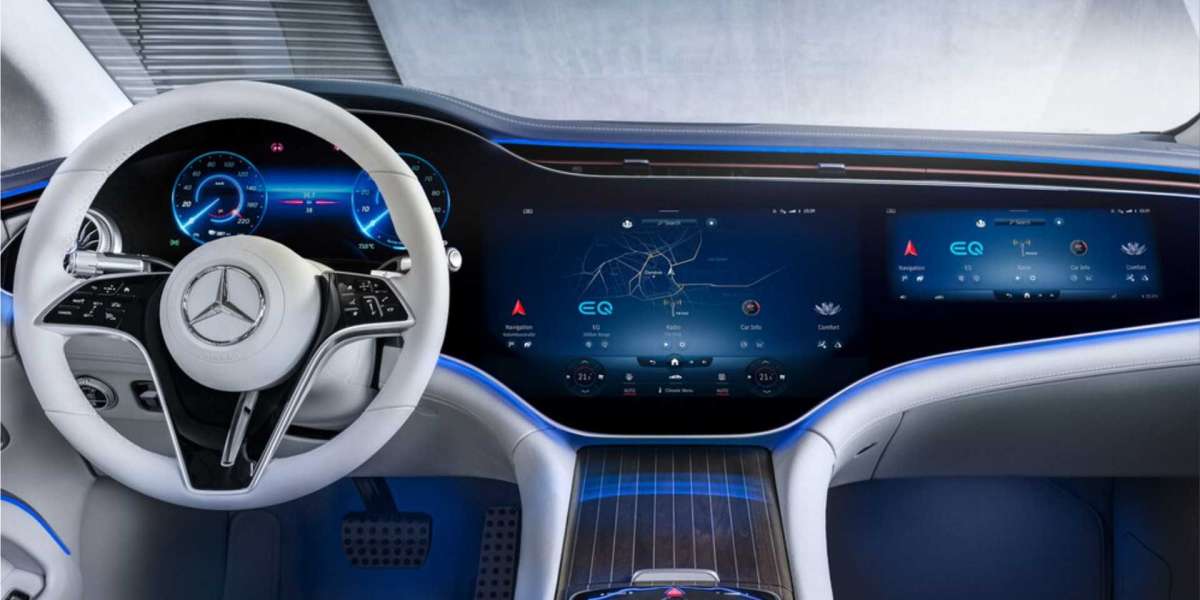The EQS is the first luxury saloon with a battery-electric drive from Mercedes-EQ. With the introduction of this model, Mercedes-EQ sets new standards in this market segment. The EQS is also the first model based on modular architecture for luxury and high-end electric vehicles. The EQS excites its driver and passengers with a fascinating fusion of technology, design, functionality, and connectivity. The first models for sale are the EQS 450+ with 245 kW and the EQS 580 4MATIC with 385 kW. Consumption values according to WLTP: electricity consumption of the EQS 450+ in the mixed cycle 19.8-15.8 kWh / 100 km, CO 2 emissions 0 g / km; electricity consumption of the EQS 580 4MATIC in the mixed cycle 21.4-18.3 kWh / 100 km, CO 2 emissions 0 g / km.
Within its strategic Ambition 2039 program, Mercedes-Benz is working hard to offer a complete fleet of new CO 2- neutral cars in less than 20 years. Until 2030, more than half of the vehicles marketed by the company will be equipped with electric drive, both exclusively electric cars and plug-in hybrid models. There are many sectors in which Mercedes-Benz is already thinking about tomorrow today. This is reflected in the sustainability that the design of the new EQS guarantees. Vehicles are produced with a neutral CO 2 balance, using materials that help preserve natural resources, such as carpets made from recycled yarn. Mercedes-Benz's strategy encompasses the entire value creation chain, from development and supplier network to production itself. In addition, Mercedes-Benz AG has submitted its climate protection objectives to a scientific audit by the Science-Based Targets Initiative (SBTI).
As a result of combining a specific design for an electric vehicle - what the designers call 'Purpose-Design' - with the systematic refinement of the details and close cooperation with the designers, the team of aerodynamic specialists has succeeded in establishing a new world record, with a coefficient of resistance cx of 0.20. With this, the EQS is the world's most aerodynamic mass-produced car. The advantages are obvious, especially in terms of autonomy. Also notable is acoustic comfort, another field in which the EQS is one of the best in the world. The very low level of driving noise makes a significant contribution to this.
The Mercedes-Benz EQS also stands out in the chapter on energy recovery. Of the maximum deceleration capacity in the D Auto recovery program, which amounts to 5 m / s², it is possible to carry out by recovery up to 3 m / s² (the rest, 2 m / s², is achieved by means of the service brake). In this way, it is possible to decelerate the vehicle to a stop without pressing the brake pedal. The chosen recovery strategy also benefits the range and high electrical energy recovery power (up to 290 kW). The car also decelerates if it recognizes vehicles driving ahead until it comes to a stop, for example, at a traffic light. Intelligent recovery is optimized depending on the situation with the help of the ECO assistant. It can intervene in anticipation, taking into account external factors such as traffic conditions or topography.
The Mercedes-Benz EQS fully meets the expectations of a modern saloon in the S-Class segment with a range of up to 780 kilometers (according to the WLTP cycle) and an output of up to 385 kW. Later it is planned to introduce a high-performance version, with a power of up to 560 kW. All EQS models operate with an electric powertrain (eATS) on the rear axle. The 4MATIC versions are equipped with an additional eATS on the front axle.
With the Mercedes-Benz EQS, a new generation of high-performance batteries is introduced, with a clearly higher energy density. The company's own battery management software enables over-the-air upgrades using Over-the-Air (OTA) technology. This ensures that energy management uses current software throughout the entire life cycle of the car. In the chemical composition of the cells, the percentage of cobalt in the cathodes has been reduced to 10%.
The Mercedes-Benz EQS battery can be recharged in DC fast-charging stations with a power of up to 200 kW. Thus, 15 minutes is enough to obtain the electrical energy necessary to travel an additional 300 kilometers (according to the WLTP cycle). The Mercedes-Benz EQS can also be conveniently charged at home or public charging stations using the onboard AC charger, with a charging power of up to 22 kW. In Japan, the EQS will also allow bi-directional charging, that is, the exchange of electricity in both directions. Added to this are innovative charging programs, which can be activated automatically based on location, as well as features that help reduce the stress on the battery while charging.
Navigation equipment with Electric Intelligence evaluates numerous factors to plan the fastest and most comfortable route to the destination, including stops to recharge the battery, and reacts dynamically to various events, such as a hold or changes in driving style. New to the EQS is the display on the MBUX (Mercedes-Benz User Experience) infotainment system of indications, for example, whether the current battery capacity is sufficient to return to the starting point without charging the battery. When calculating the route, priority is given to charging stations added manually by the driver and located along the route. It is also possible to exclude the charging stations suggested by the system. The program calculates the foreseeable costs of the load at each stop.

The Mercedes-Benz EQS electric car is closely related to the new S-Class but is based on its own architecture platform, created for models with exclusively electric propulsion. This completely new conception makes it possible to choose the design elements according to the development objectives freely. The design philosophy based on sensual clarity, combined with advanced luxury or "Progressive Luxury," is reflected in the patterned surfaces, reduced visible joints, and seamless transitions between the different volumes (Seamless Design).
The front shows a holistic design, which configures in its interaction the so-called Black Panel unit. Innovative headlights, joined by a luminous band and a radiator grille in deep black (Black Panel), create a completely autonomous appearance. Furthermore, anyone who wishes can accentuate the exclusivity of the Black Panel radiator grille with the Mercedes star in a central position. To do this, choose the front with a three-dimensional star design available as optional equipment. This design element, called the Mercedes-Benz pattern, is functional with the AMG Line Exterior line or the Electric Art Exterior line and is based on the Daimler-Motorengesellschaft primitive star design, registered as a graphic trademark in 1911.
The EQS is the first Mercedes-Benz car to offer the possibility of retrofitting completely new functions in various sectors using "Over-the-Air" (OTA) updates. The offer on the market launch date includes two special driving programs for young drivers and service personnel, miniature games, and the demonstration program "The best or nothing." Their help makes it possible to adapt some EQS equipment after purchase and original configuration, according to specific customer preferences. It will also be possible to enable the rear-axle steering to operate with the highest wheel orientation angle of 10 ° on vehicles produced from the beginning of 2022. Along with the classic purchase of individual functions, subscriptions, temporary activations, and free trial phases are also planned.
Mercedes-Benz offers a complete solution to improve air quality inside the EQS: the Energizing Air Control Plus system. The equipment is based on several pillars: filtering, sensors, visualization concept, and air treatment. The HEPA filter(High-Efficiency Particulate Air, high-efficiency filter for particles) purifies the exterior air entering the passenger compartment with a very high level of filtration, retaining fine dust, microparticles, pollen, and other substances. The activated carbon coating, in turn, reduces the concentration of sulfur dioxide and nitrogen oxides. The HEPA filter is certified "OFI CERT" ZG 250-1 for viruses and bacteria. The pre-conditioning function makes it possible to purify the interior air even before the occupants take a seat on board. MBUX reports the concentration of fine dust inside and outside the vehicle. These data can be consulted in their air quality menu. If the outdoor air quality is inadequate, the system can issue recommendations. For instance,
The Mercedes-Benz EQS can be optionally equipped with automatic comfort doors at the front and at the rear. As the driver approaches the vehicle, the door handles are first extended. Then, if you keep coming, the driver's door opens automatically. MBUX also offers the driver the possibility of opening the rear doors with the remote control function, for example, to allow the children to get on when they are picked up from school.
The Mercedes-Benz EQS is a brilliant electric vehicle, equipped with a maximum of 350 sensors, depending on the equipment. These elements record distances, speed and acceleration, ambient light, rain intensity, and temperature, determine seat occupancy and even analyze driver blinks or the language spoken by passengers. The information is processed with the help of control units, which make decisions in fractions of a second with the use of specialized algorithms. It can be said that these electronic switchboards are the brain of the car. The new EQS can hone its skills as it gains new experiences, as it is capable of learning with the help of artificial intelligence (AI) techniques.
The broad soundstage in the Mercedes-Benz EQS cabin clearly manifests the paradigm shift from the combustion engine to the electric car. Various acoustic concepts can be used to create a personalized acoustic environment. Combined with the Burmester surround sound system, the Mercedes-Benz EQS offers two acoustic ideas, called Silver Waves and Vivid Flux. The driver can select them as Sound Experiences on the center display, and you can turn them off if you prefer. There is an additional acoustic concept called Roaring Pulse, which can be purchased and activated with the help of "Over-the-Air" upgrade technology. The interactive driving sound, reproduced in the passenger compartment via the sound system loudspeakers, also depends on the acoustic concept selected.
A novelty in Energizing Comfort is the three Energizing Nature programs: forest clearing, wave breaking, and summer rain. These programs recreate an immersive and, therefore, amazingly realistic acoustic experience in the vehicle. The calming effect sounds have been developed in cooperation with nature acoustician Gordon Hempton. As in the other Energizing Comfort programs, the light environment and images are used to stimulate different senses.
One piece of equipment that makes a decisive contribution to the dynamic and maneuverable impression of the Mercedes-Benz EQS is the rear axle steering fitted as standard., with an angle of orientation of the wheels of up to 4.5 °. As an alternative option, it can be replaced by rear-axle steering with a wheel turning angle of up to 10 °. The customer can opt for this equipment at the time of purchase or enable it later through an over-the-air (OTA) wireless update on vehicles produced from the beginning of 2022. The increase in the steering angle of the wheels is linked to a decrease in the turning diameter of the EQS to 10.9 meters, despite its length of more than five meters. This value is impressive and is comparable to the turning diameter of many cars in the compact class. The central display shows the steering angle of the rear axle wheels and the corresponding trajectory in the driving programs menu.
Thanks to the high-performance sensors that scan the vehicle environment, the parking assistance systems can provide better assistance to the driver in maneuvers. The remote parking assistant helps the driver to park and unpark his vehicle using the smartphone. Suppose pre-installation has been chosen for the INTELLIGENT PARK PILOT. In that case, the EQS is ready to participate in Automated Valet Parking (AVP, SAE Level 4) in parking lots prepared for this function. In combination with the necessary optional equipment and the corresponding connect service (depending on the country), the EQS incorporates the technique to park and unpark in a fully automated and driverless way in car parks with AVP infrastructure, provided that the national legislation of the country in which the operation of these systems is found.
The revolutionary Digital Light headlamp technology (standard from the Advanced Plus equipment level) makes it possible to implement completely new functions, such as the projection of auxiliary lines or warning symbols on the road. New are two-assist functions called Cooperative Lane Change Start Display and Direction Warning / Indication if a hazard is recognized by the Lane Keeping Assist or Blind Spot Assist. The Digital Light has in each headlamp a lighting module with three high-power LEDs and 1.3 million miniature mirrors, which reflect and refract light. In this way, the vehicle lighting achieves a definition higher than 2.6 million pixels.
If equipped with the optional Drive Pilot system, the Mercedes-Benz EQS will be able to move with a high degree of automation up to a speed of 60 km/h in situations with heavy traffic or retention in Germany, provided that the motorway section is suitable for this. This saves the driver work and gives him time to devote to other activities, such as surfing the Internet or checking his e-mails at the In-Car-Office on wheels.
A particularly prominent interior feature, which is standard on the EQS 580 4MATIC, is the MBUX Hyperscreen. This large warped screen gracefully stretches between the two front pillars, practically from side to side of the vehicle. Three screens arranged under a cover glass make up an optical unit. The 12.3-inch diagonal OLED display in front of the passenger seat provides its occupant with their viewing and operating area. The entertainment functions are available during the march only within the framework of the legal regulations in force in each country. To ensure compliance with this restriction, Mercedes-EQ uses an intelligent, camera-based logic scheme. If the camera senses that the driver is looking at the front passenger display, certain content is automatically dimmed.
Using learning-capable software, MBUX adapts to its user preferences and presents customized proposals for numerous infotainment, comfort, and vehicle functions. Depending on the situation and context, the most critical applications are always offered in the driver's field of vision in the upper plane of MBUX, the so-called Zero-Layer layer.
The new generation of driver assistance systems comprises numerous functions that ease the burden on the driver. New is, for example, Attention Assist's additional warning of the danger of micro-dreams. This function analyzes the driver's flicker with the help of a camera integrated into the driver's display (only in conjunction with the MBUX Hyperscreen). In addition, the new assistance screen on the driver's display shows the operation of the driving assistance systems in an easy-to-understand way.
The principles of comprehensive security, especially accident protection, apply regardless of the platform on which the vehicle is based. The Mercedes-Benz EQS features a special passenger compartment, special controlled deformation zones, and modern restraint systems like all other Mercedes-Benz cars. Also, PRE-SAFE is part of the standard equipment. The fact that the Mercedes-Benz EQS is based on a specific architecture for electric vehicles opens up new configuration possibilities regarding safety. For example, choosing an area on the underside to house the battery is possible, protected from potential impacts. Furthermore, as there is no big rigid motor block, the structure can be configured better to withstand the dynamic phenomena during a frontal collision. Along with the standard crash tests, other tests have been carried out in the Automotive Safety Technology Center (TFS) to validate additional assumptions and extensive component testing.








